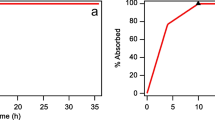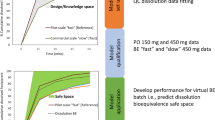Abstract
Bioequivalence assessment of extended release (ER) dosage forms is usually carried out at steady-state, using area under the curve (AUC) to evaluate extent of absorption and maximum concentration (Cmax) and % peak trough fluctuation ratio (%PTF) to evaluate rate of absorption. Other metrics such as Cmax/AUC and partial AUCs have recently been proposed as alternatives for assessing the absorption rate of drugs from immediate release (IR) dosage forms under single dose conditions. The performances of these metrics were assessed using the results of two sets of simulated experiments of ER dosage forms at steady-state and 2 actual pharmacokinetic studies involving ER dosage forms of a Glaxo drug. In the first set of simulations there was no difference in bioavailability between the two formulations; in the second set of simulations the test formulation had a 50% greater absorption rate-constant (ka) than the reference formulation. The following conclusions were reached: 1. For ER dosage forms at steady-state, all the metrics, with the exception of %PTF, resulted in much smaller increases than the underlying 50% increase in ka. Although, %PTF gave the largest effect it was also the most imprecisely estimated. 2. In our studies, none of the metrics tested provided reliable information about changes in the underlying rate of absorption from ER dosage forms under steady-state conditions. 3. The current practice of comparing rate of absorption from ER dosage forms using steady-state Cmax is inappropriate due to lack of sensitivity. The use of %PTF may require a widening in the currently accepted 80-125% permissible range set for Cmax and AUC.
Similar content being viewed by others
REFERENCES
Dighe SV, Adams WP. Bioequivalence: A United States Regulatory Perspective. Pharmaceutical Bioequivalence. Volume 48 of Drugs and the Pharmaceutical Sciences, Mercel Dekker Inc, New York, 1991, pp 347–380.
Tse FLS, Robinson WT, Choc MG. Study Design for the Assessment of Bioavailability and Bioequivalence. Pharmaceutical Bioequivalence. Volume 48 of Drugs and the Pharmaceutical Sciences, Mercel Dekker Inc, New York, 1991, pp 17–34.
Hauschke D, Steinijans VW. Modified-release dosage forms: Acceptance criteria and statistics for bioequivalence. Drug Info. J. 27: 903–909 (1993).
Lacey LF, Keene ON, Duquesnoy C, Bye A. Evaluation of different indirect measures of rate of drug absorption in comparative pharmacokinetic studies. J. Pharm. Sci. 83(2):212–215 (1994).
Williams RL. Bioequivalence and Therapeutic Equivalence. Pharmaceutical Bioequivalence. Volume 48 of Drugs and the Pharmaceutical Sciences. Mercel Dekker Inc, New York, 1991, pp 1–15.
Endrenyi L, Fritsch S, Yan W. Cmax/AUC is a clearer measure than Cmax for absorption rates in investigations of bioequivalence. Int. J. Clin. Pharmacol. Ther. and Toxicol. 29:394–399 (1991).
Chen M-L. An alternative approach for assessment of rate of absorption in bioequivalence studies. Pharm. Res. 9(11), 1380–1385 (1992).
Macheras P, Symillides M, Reppas C. Estimation of absorption rate-constant in a one-compartment model using the profile of the bioavailable dose eliminated as a function of multiples of half-life. J. Pharm. Sci. 82(12):1298–1300 (1993).
Wagner JG. Fundamental of Clinical Pharmacokinetics. Drug Intelligence Publications Inc, 2nd edition, Hamilton, Illinois, 1979.
Miller R, Ludden TM. Bioavailability of controlled release carbamazepine by mixed effect modelling. Eur. J. Clin. Pharmacol. 44:231–235 (1993).
Eldon MA, Colburn WA. Influence of absorption rate, dosing frequency, and intrinsic pharmacokinetic profile on steady-state drug concentrations. Pharmaceutical Research. 7:677–680 (1990).
Pabst G, Jaeger H. Review of methods and criteria for the evaluation of bioequivalence studies. Eur. J. Clin. Pharmacol. 38, 5–10 (1990).
Guidance: Statistical procedures for bioequivalence studies using a standard two-treatment crossover design. Office of Generic Drugs, FDA, July 1992.
Guidance: Oral extended (controlled) release dosage forms. In vivo bioequivalence and in vitro dissolution testing; Office of Generic Drugs, FDA, September 1993.
Bois FY, Tozer TN, Hauck WW, Chen M-L, Patnaik R, Williams RL. Bioequivalence: Performance of several measures of extent of absorption. Pharm. Res. 11(5), 715–722 (1994).
Author information
Authors and Affiliations
Rights and permissions
About this article
Cite this article
Reppas, C., Lacey, L.F., Keene, O.N. et al. Evaluation of Different Metrics as Indirect Measures of Rate of Drug Absorption from Extended Release Dosage Forms at Steady-State. Pharm Res 12, 103–107 (1995). https://doi.org/10.1023/A:1016246922519
Issue Date:
DOI: https://doi.org/10.1023/A:1016246922519




